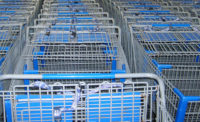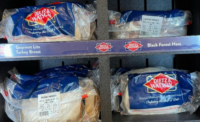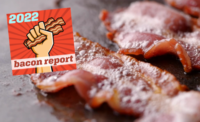Sausage sales growth around the mid-point of 2022 has cooled a bit from its previous two years of double-digit growth, but both the breakfast and dinner sausage categories maintain overall growth despite retail price inflation
“Sausage is incredibly popular, so even when there is inflation the impact on sales isn’t always as strong as it is in some of the other meat categories,” National Hot Dog & Sausage Council President Eric Mittenthal said.
Overall retail sales of breakfast sausage for the 52-week period ending April 24, 2022, were $2.06 billion, up 2.1% from a year ago at the same time but up 13.9% from 2020 and up 22.9% from 2019, according to IRI monthly shopper survey data. Dinner sausage sales were more than double those of breakfast sausage, at $4.66 billion, up 1.6% from 2021, 11.1% from 2020, and 22.1% from 2019
“Relative to some of the other whole-muscle cuts, you continue to see affordability in sausage, and that’s probably why the performance of sausage has been strong ever since the start of the pandemic,” said Anne-Marie Roerink, principle at 210 Analytics.
At foodservice, demand also has remained strong, Mittenthal said, adding that inflation has impacted overall sales at retail, with sales being up dollar-wise but down in volume. Sausage’s performance has been consistent with the rest of the meat category, he said.
Roerink said more people working from home since the pandemic has improved previously strong sales for frozen breakfast sandwiches and other ready-to-eat items as well as breakfast sausage and dinner sausage, which is often eaten for other meal occasions.
“Especially during COVID we saw an enormous strength in the total sausage category,” she said. “I think part of that was which meal occasions ended up moving from foodservice — or just on the go — to the home. One that really jumps out is the breakfast occasion.”
The sales gains retail made during the pandemic as foodservice demand fell continue to power creative growth at the store level.
“You also see sausage expanding as a part of the total service counter area. A lot of stores actually take sausage as a way to develop items that are proprietary to them,” she said. “So it really has become an area of differentiation.”
Sausage products’ affordability and flexibility has not gone unnoticed in other food sales channels.
“I’ve seen them popping up in meal kits recently, so that’s probably a way in which meal kits can keep a little bit of a more favorable price point,” Roerink said.


Branding matters
Breakfast and dinner sausage brands in general enjoy strong consumer loyalty, often based on consumers having grown up eating the brand or the sausage being a regional culinary mainstay, Roerink said.
“This is an area where I think we’ve seen national brands and private brands work beautifully hand in hand,” she said.
Mittenthal, who also serves as chief strategy officer for the North American Meat Institute, said sausage has been benefitting from more than a decade of increasing consumer demand.
“We’ve seen kind of category switching to an extent, where people who would previously buy hot dogs are buying a little bit more in the sausage category,” he said.
Retail studies suggest sausage purchasers are creatures of habit. Brand loyalty is a key factor in consumer sausage purchasing decisions.
According to Power of Meat survey data, in 2012 63% of consumers said they did not have a brand preference when purchasing processed meat products such as sausage, Roerink said. In the 2022 study, that had fallen to 29%. Nearly half of those surveyed (45%) stated a preference for a specific regional or national brand, compared with 26% expressing a preference for a private-label brand. She said the growth in brand loyalty has trended up generationally from Baby Boomers to Gen-Xers to Millennials and Gen Z, with each successive demographic group expressing stronger brand loyalty.
In a grocery marketplace still contending with supply chain shortfalls, consumers’ brand loyalty to a specific sausage brand can potentially negatively impact the overall category, Roerink said. For example, instead of purchasing a different brand of sausage in place of an out-of-stock favorite, the shopper could opt for a product outside the sausage category entirely.
Flavor trends
In a category as broad and varied as sausage, interesting and tasty innovations always abound. Product development in the sausage category has benefited from new flavor formulations as well as increasingly popular new proteins.
“We’re seeing some really interesting flavors,” Roerink said., naming Kayem Meats and its sausages with flavor profiles such as pepper jack, pineapple bacon, and sweet bell pepper provolone.
Taking the flavor innovation up another level, the Al Fresco brand’s Tastes Just Like line of chicken sausage products includes some unexpected flavors, such as Chicken Burrito, Nashville Hot Chicken, Chicken Parm, and Fried Rice. Another innovation is blending vegetables such as broccoli, kale, or mushrooms into sausage, Roerink said.
“There has been so much innovation in the entire breakfast and dinner sausage categories,” she said. “People can really have fun with the flavors
Sausage market highlights
- In 2021, Americans spent more than $7.5 billion on hot dogs and sausages in U.S. grocery stores.
- Dinner sausage sales topped $4.8 billion and weighed in at nearly 1.27 billion pounds in 2020, a 15% volume increase from 2019. For the same time period, breakfast sausage sales were more than $1.46 billion and 361.5 million pounds (up 15.5%).
- Dinner sausage sales peak during the summer, with dollar sales accounting for nearly a third of annual sales.
- Breakfast sausage sales peak during the holiday season from November through January.
- Consumption of dinner sausage is fairly uniform across income levels, while lower-income families consume the most breakfast sausage.
- Larger families eat the most breakfast and dinner sausage, as do younger families. Sausage consumption cools considerably for senior citizens.
- The Big Apple has a big appetite for sausage, with New York leading the way in dinner sausage sales, at $148.3 million. Los Angeles and Chicago are the second and third-largest markets, with sales of $140.8 million and $110.6 million, respectively. Dinner sausage sales peak during the summer, with dollar sales accounting for nearly a third of annual sales.

.png?height=96&t=1647275041&width=96)



Report Abusive Comment